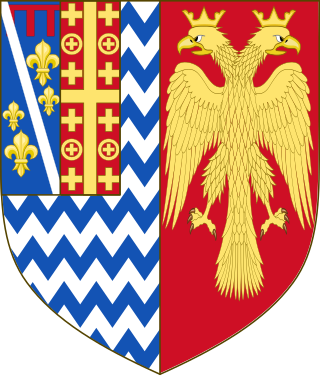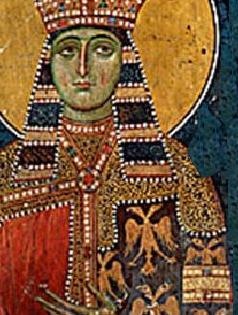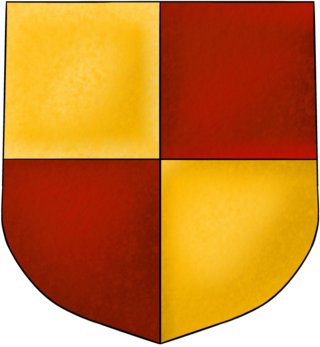Related Research Articles

The Principality of Achaea or Principality of Morea was one of the vassal states of the Latin Empire, which replaced the Byzantine Empire after the capture of Constantinople during the Fourth Crusade. It became a vassal of the Kingdom of Thessalonica, along with the Duchy of Athens, until Thessalonica was captured by Epirus in 1224. After this, Achaea became the dominant power in Greece, lasting continuously for 227 years and cumulatively for 229.
The Prince of Achaea was the ruler of the Principality of Achaea, one of the crusader states founded in Greece in the aftermath of the Fourth Crusade (1202–1204). The principality witnessed various overlords during its more than two centuries of existence, initially, Achaea was a vassal state of the Kingdom of Thessalonica under Boniface I of house Montferrat, then of the Latin Empire of Constantinople under the houses of Flanders-Courtenay, which had supplanted the Byzantine Empire, and later of the Angevin Kingdom of Naples. During the Angevin period, the princes were often absent, represented in the Principality by their baillis, who governed in their name. After 1404 the principality became sovereign as the Genoese Centurione II Zaccaria bought from the Neapolitan crown the princely rights.

The Despot of Epirus was the ruler of the Despotate of Epirus, one of the rump states of the Byzantine Empire in the aftermath of the Fourth Crusade. The name "Despotate of Epirus" and the title "despot of Epirus" are modern historiographical names, and were not in use by the despots themselves. In the Byzantine Empire, the title of despot was a prestigious court title and did not designate rule over some specific territory. Though several of the early Greek rulers of the Epirote realm did use the title of despot, it was never in reference to the lands they governed, but instead in reference to their position in the imperial hierarchy.
Carlo I Tocco was the hereditary Count Palatine of Cephalonia and Zakynthos from 1376, and ruled as the Despot of Epirus from 1411 until his death on July 4, 1429.
Centurione II AsanesZaccaria, scion of a powerful Genoese merchant family established in the Morea since the marriage of the lord of Chios Martino Zaccaria to the baroness Jacqueline de la Roche. Centurione purchased the rights of the title of Prince of Achaea by Ladislaus of Naples in 1404 and was the last ruler of the once Latin Empire not under Byzantine suzerainty.

Glarentza, also known as or Clarenia, Clarence, or Chiarenza, was a medieval town located near the site of modern Kyllini in Elis, at the westernmost point of the Peloponnese peninsula in southern Greece. Founded in the mid-13th century by William II of Villehardouin, the town served as the main port and mint of the Frankish Principality of Achaea, being located next to the Principality's capital, Andravida. Commerce with Italy brought great prosperity, but the town began to decline in the early 15th century as the Principality itself declined. In 1428, Glarentza was ceded to the Byzantine Despotate of the Morea, and served as its co-capital, being the residence of one of the Palaiologos despots, until the Ottoman conquest in 1460. Under Ottoman rule, Glarentza declined rapidly as the commercial links with Italy were broken, and by the 16th century was abandoned and falling into ruin. Little remains of the town today: traces of the city wall, of a church and a few other buildings, as well as the silted-up harbour.

The Morea revolt of 1453–1454 was a failed rebellion carried out against the rule of the brothers Thomas and Demetrios Palaiologos, rulers of the Byzantine Despotate of the Morea in the Peloponnese peninsula.

Helena Palaiologina was a Byzantine princess who married Serbian Despot Lazar Branković, who ruled from 1456 until his death in 1458. After Smederevo fell to the Ottoman Turks on 20 June 1459, she fled Serbia for the Greek island of Lefkada, where she converted to Catholicism.

The House of Tocco was an Italian noble family from Benevento that came to prominence in the late 14th and 15th centuries, when they ruled various territories in western Greece as Counts Palatine of Cephalonia and Zakynthos and Despots of Epirus. During their brief period of rule in Greece, they were one of the most ambitious and able Latin dynasties in the region, and were one of the few to leave descendants lasting nearly until modern times, in which they claimed to represent the senior matrilineal heirs of the Palaiologos dynasty.
Centurione I Zaccaria was one of the most powerful nobles of the Principality of Achaea in the 14th century. He was the firstborn son of Martino Zaccaria and Jackqueline de la Roche, last representant of the prestigious Burgundian house of the Duchy of Athens. In 1334 Centurione succeeded his brother, Bartolomeo Zaccaria as baron of Damala. After the death of Martino he rose as lord of one half of the Barony of Chalandritsa, and in 1359 he acquired the other half. In about 1370 he was named Grand Constable of Achaea and received also the Barony of Estamira. He also thrice held the post of bailli (viceroy) for the principality's Angevin rulers.

The Battle of the Echinades was fought in 1427 among the Echinades islands off western Greece between the fleets of Carlo I Tocco and the Byzantine Empire. The battle was a decisive Byzantine victory, the last in the Empire's naval history, and led to the consolidation of the Peloponnese under the Byzantine Despotate of the Morea.

Maria II Zaccaria Asanina was a Princess of Achaea.
Leonardo II Tocco was a scion of the Tocco family and lord of Zakynthos, who played an important role as a military leader for his brother, Carlo I Tocco, in early 15th-century western Greece.

The Barony of Estamira or Stamira was a medieval Frankish fiefdom of the Principality of Achaea, located in the fertile plains of the Elis region of the Peloponnese peninsula in Greece, and centred on the now vanished fortress of Estamira.
Andronikos Asen Zaccaria or Asanes Zaccaria was a Genoese lord of the Principality of Achaea in southern Greece.
John Asen Zaccaria or Asanes Zaccaria was the firstborn son of Centurione II Zaccaria and a Byzantine princess from the Asen branch of the imperial Palaiologos family.
Catherine Asenina Zaccaria or Catherine Palaiologina was the daughter of the Prince of Achaea, Centurione II Zaccaria and a Byzantine lady hailing from the prestigious houses of Asen-Palaiologos and the house of Tzamblakon. In September 1429 she was betrothed to the Byzantine Despot of the Morea Thomas Palaiologos, and married him in January 1430 at Mystras.
Don Antonio Tocco was the last titular Despot of Epirus and Count Palatine of Cephalonia and Zakynthos, claiming these titles from the death of his father Leonardo V Tocco in 1641 until he abandoned them in 1642, substituting them for the Neapolitan title of Prince of Achaea, which he used until his death in 1678.

The House of Zaccaria de Damalà, more commonly known as Damalas today, is a formerly ruling princely family of Genoese origin, established in the 14th century on the island of Chios as the result of the marriage of Genoese admiral Benedetto I Zaccaria with a sister of Byzantine Emperor Michael VIII Palaiologos, and which ultimately produced the last ruling dynasty of the Principality of Achaea.
Catherine Le Maure was a French noblewoman of the Principality of Achaea. She was the de facto Baroness of Arcadia and Lady of Saint-Sauveur. She was the eldest daughter of the Erard III Le Maure, Baron of Arcadia. She had two sisters, Lucie and Marie and a brother that died young. At the end of the 14th century Catherine married to Andronikos Asen Zaccaria, the leader of the great Genoese Zaccaria house of Morea. Andronikos was one of the strongest men inside the Principality as Grand Constable of Achaea and Baron of Chalandritsa, Estamira and Lysarea.
References
- 1 2 3 Sturdza, Mihail Dimitri (1999). Grandes familles de Grèce: d'Albanie et de Constantinople (in French). pp. 371–373.
- ↑ Sansaridou - Hendrickx, Thecla (2008). The Chronicle of the Tocco. Greeks, Italians, Albanians and Turks in the Despotate of Epirus (14th-15th centuries) (in Greek). Thessaloniki: Stamoulis. p. 165. ISBN 9789606741999.
- ↑ Setton, Kenneth (1975). A History of the Crusades, The Fourteenth And Fifteenth Centuries. The University of Wisconsin Press. p. 163.
- ↑ Sansaridou - Hendrickx, Thecla (2008). The Chronicle of the Tocco. Greeks, Italians, Albanians and Turks in the Despotate of Epirus (14th-15th centuries) (in Greek). Thessaloniki: Stamoulis. pp. 175–176. ISBN 9789606741999.
- ↑ Thomopoulos, Stephanos. History of the City of Patras, From the Ancient Times Until 1821. Achaean Publications. p. 47. ISBN 960-7960-09-2.
- ↑ Nicol, Donald M. (1992). The immortal emperor: the life and legend of Constantine Palaiologos, last emperor of the Romans. p. 12.
- ↑ Chalkokondyles, Laonikos (2014). The Histories. Harvard University Press. p. 401. ISBN 978-0-674-59919-2.
- ↑ Thomopoulos, Stephanos. History of the city of Patras, from the ancient times until 1821. Achaean Publications. p. 47. ISBN 960-7960-09-2.
- ↑ Sphrantzes, Georgios. Short History (in Greek). Athens: Kanakis. p. 227. ISBN 960-7420-94-2.
- ↑ https://commons.wikimedia.org/wiki/File:Agnatic_Descendants_of_Martino_Zaccaria.jpg Agnatic descendants of Martino Zaccaria de Chios e Damalà based on the research of Michele Soulli, AGP accredited genealogist, 2023.